1990 VOLKSWAGEN TRANSPORTER service
[x] Cancel search: servicePage 105 of 165
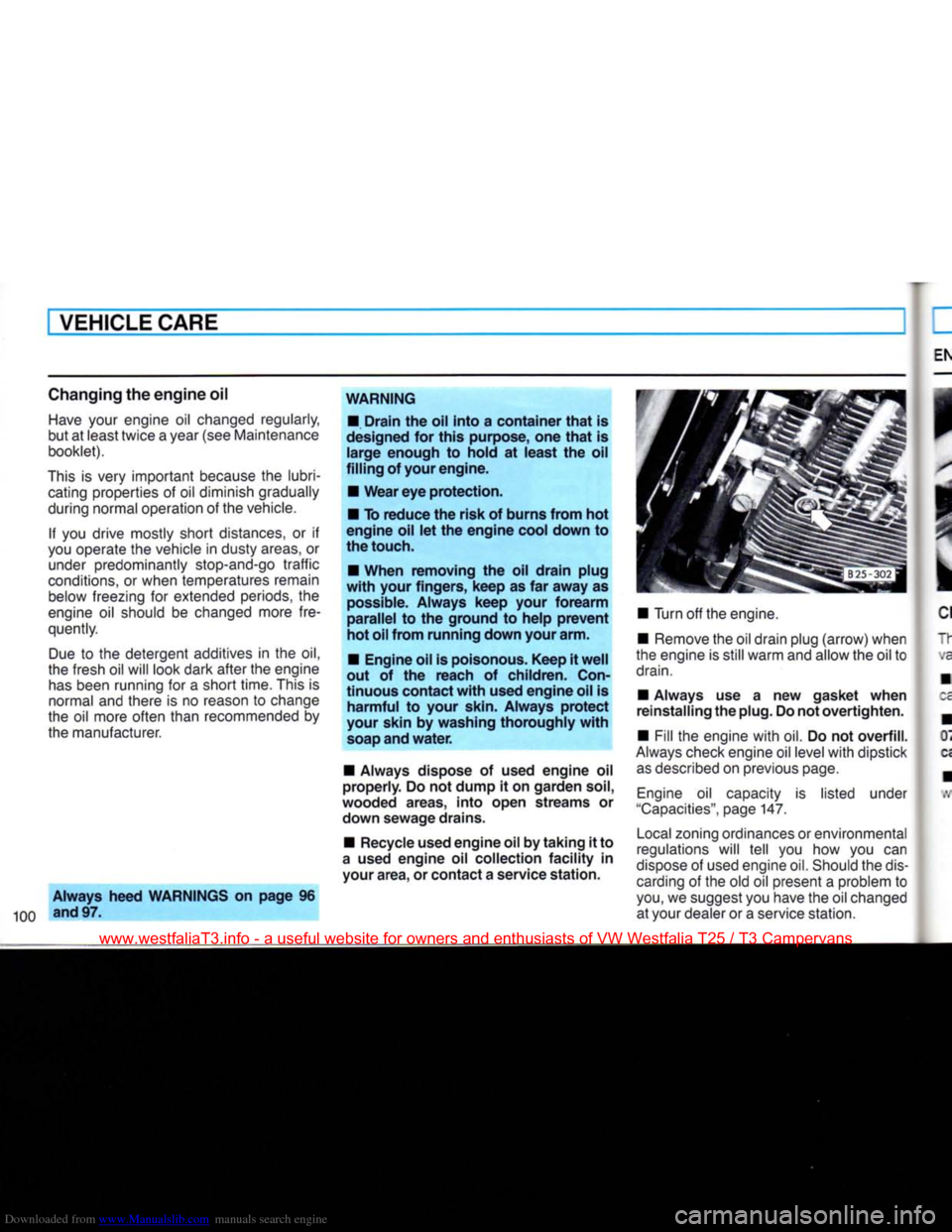
Downloaded from www.Manualslib.com manuals search engine
VEHICLE CARE
Changing the
engine
oil
Have
your engine oil changed regularly,
but at least twice a year (see Maintenance
booklet).
This
is very important because the lubri cating properties of oil diminish gradually
during normal operation of the vehicle.
If you drive mostly short distances, or if
you operate the vehicle in dusty
areas,
or under predominantly stop-and-go traffic
conditions, or when temperatures remain below freezing for extended periods, the
engine oil should be changed more fre
quently.
Due
to the detergent additives in the oil,
the fresh oil will look dark after the engine
has
been running for a short time. This is
normal and there is no reason to change
the oil more often than recommended by
the manufacturer.
Always
heed
WARNINGS
on
page
96
100 and97-
WARNING
•
Drain
the oil
into
a
container
that
is
designed for
this
purpose, one
that
is
large
enough to hold at
least
the oil
filling
of your
engine.
•
Wear
eye
protection.
• To
reduce
the
risk
of burns
from
hot
engine
oil let the
engine
cool
down
to
the touch.
•
When
removing
the oil
drain
plug
with
your fingers,
keep
as far
away
as possible.
Always
keep
your
forearm
parallel
to the ground to
help
prevent
hot oil
from
running
down
your arm.
• Engine oil is poisonous. Keep it
well
out of the
reach
of children. Con
tinuous
contact
with
used
engine
oil is
harmful
to your skin.
Always
protect
your skin by
washing
thoroughly
with
soap and
water.
•
Always
dispose of used
engine
oil
properly.
Do not
dump
it on
garden
soil,
wooded
areas,
into
open
streams
or
down
sewage
drains.
• Recycle used
engine
oil by
taking
it to
a used
engine
oil collection
facility
in
your
area,
or
contact
a service
station.
• Turn off the engine.
• Remove the oil drain plug (arrow) when
the engine is still warm and allow the oil to
drain.
•
Always
use a new
gasket
when
reinstalling
the plug. Do not
overtighten.
•
Fill
the engine
with
oil. Do not
overfill.
Always
check engine oil level
with
dipstick
as
described on previous page.
Engine
oil capacity is listed under
"Capacities",
page 147.
Local
zoning ordinances or environmental
regulations will tell you how you can
dispose
of used engine oil. Should the dis carding of the old oil present a problem to
you,
we suggest you have the oil changed
at your dealer or a service station.
www.westfaliaT3.info - a useful website for owners and enthusiasts of VW Westfalia T25 / T3 Campervans
Page 108 of 165
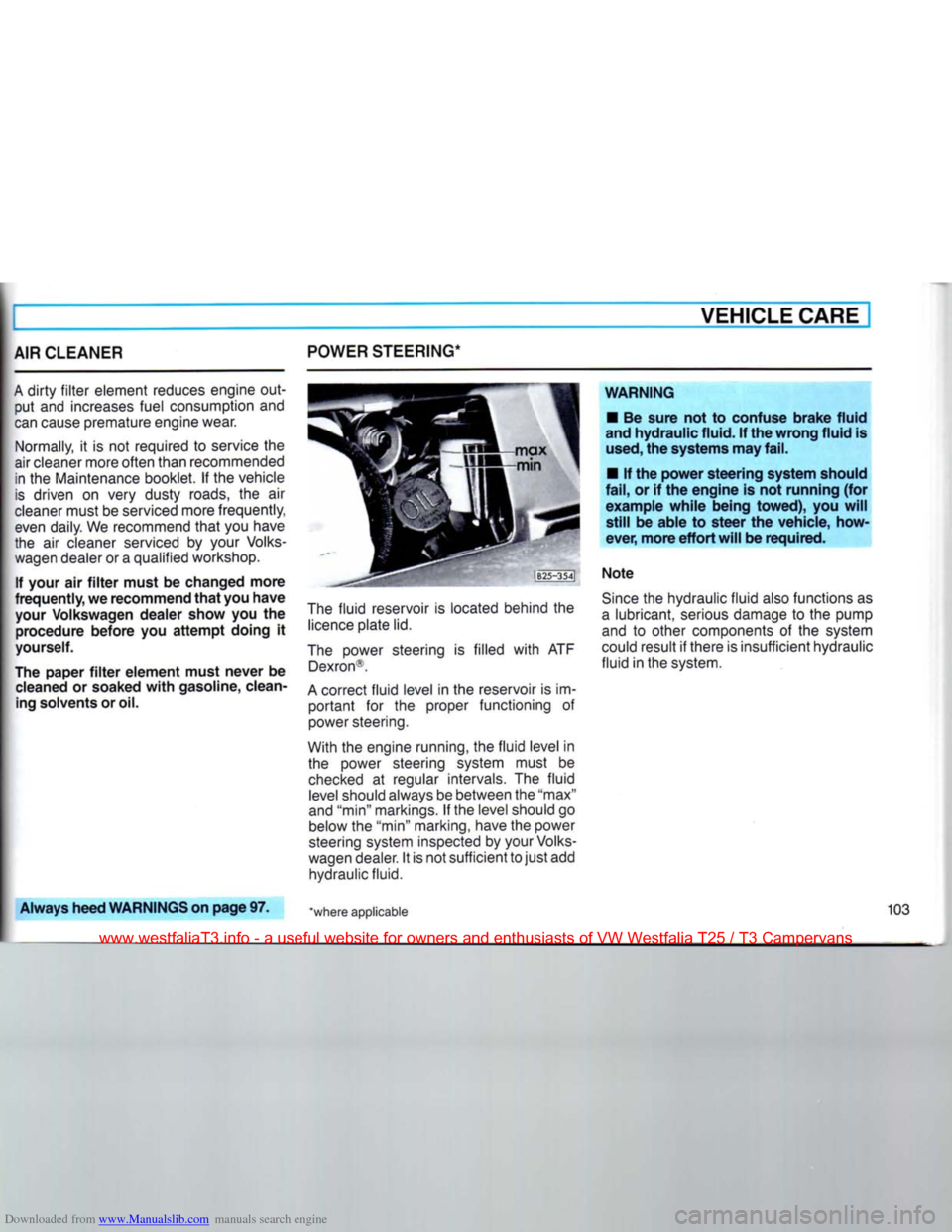
Downloaded from www.Manualslib.com manuals search engine
VEHICLE
CARE
I
AIR CLEANER
A
dirty
filter
element reduces engine
out
put and increases fuel consumption and
can
cause premature engine wear.
Normally, it is not required to service the
air cleaner more often than recommended in the Maintenance booklet. If the vehicle
is
driven on very dusty roads, the air
cleaner
must be serviced more frequently,
even
daily. We recommend
that
you have
the air cleaner serviced by your
Volks
wagen dealer or a qualified workshop.
If
your
air
filter
must
be
changed more
frequently,
we
recommend
that
you have
your
Volkswagen dealer show
you the
procedure
before
you
attempt
doing
it
yourself.
The
paper
filter
element must never
be
cleaned
or
soaked
with
gasoline, clean
ing
solvents or oil. POWER STEERING*
The
fluid
reservoir is located behind the
licence
plate lid.
The
power steering is filled
with
ATF Dexron®.
A
correct
fluid
level in the reservoir is im
portant
for the proper functioning of
power steering.
With the engine running, the
fluid
level in the power steering system must be
checked
at regular intervals. The
fluid
level
should always be between the "max"
and "min" markings. If the level should go below the "min" marking, have the power
steering system inspected by your
Volks
wagen dealer. It is not sufficient to
just
add hydraulic fluid.
WARNING
•
Be
sure
not to
confuse brake fluid
and
hydraulic fluid.
If
the wrong fluid
is
used,
the systems may fail.
•
If the
power steering system should
fail,
or if the
engine
is not
running
(for
example
while
being
towed),
you
will
still
be
able
to
steer
the
vehicle, how
ever, more
effort
will
be required.
Note
Since
the hydraulic
fluid
also functions as
a
lubricant, serious damage to the pump
and to other components of the system
could result if there is insufficient hydraulic
fluid
in the system.
Always
heed WARNINGS on page
97. "where applicable
www.westfaliaT3.info - a useful website for owners and enthusiasts of VW Westfalia T25 / T3 Campervans
Page 113 of 165
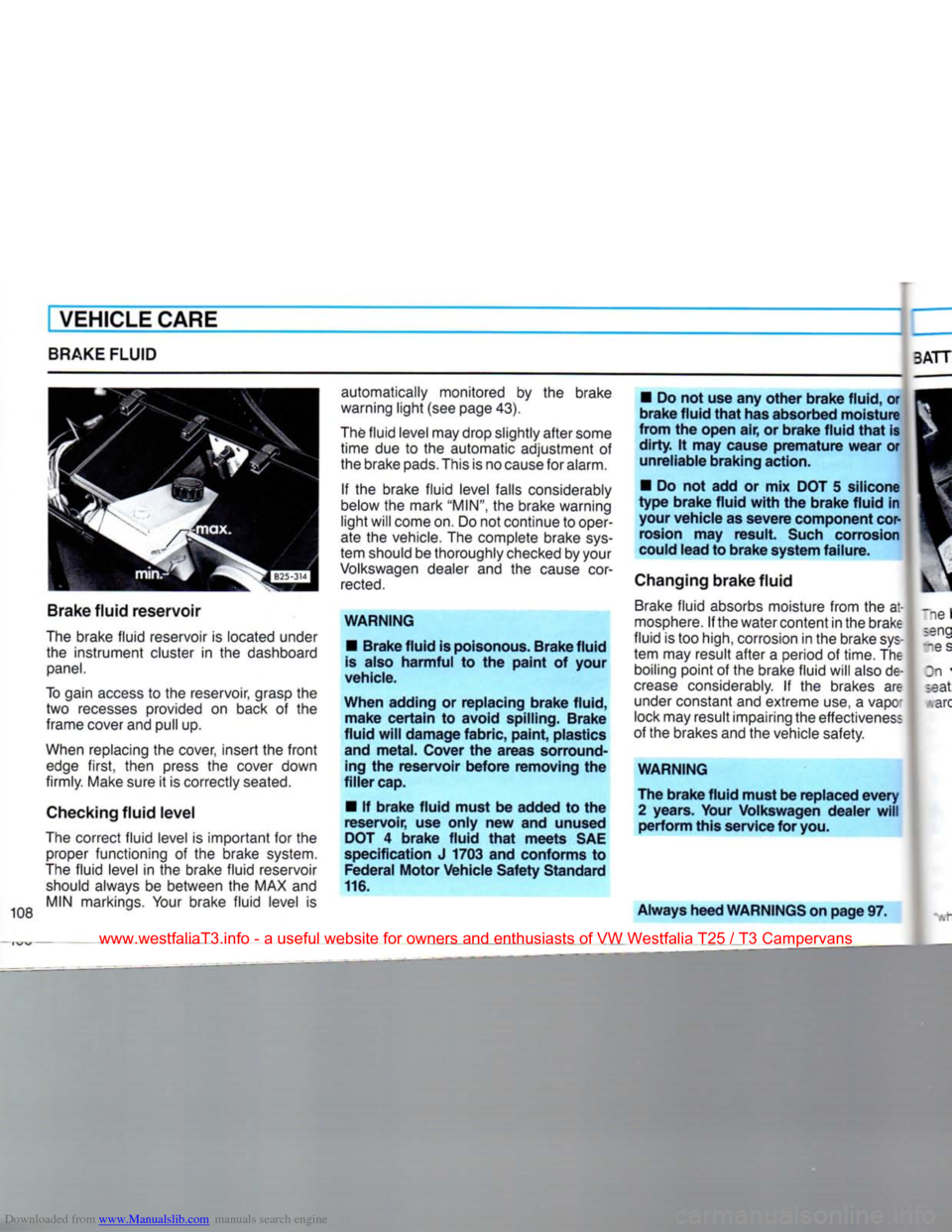
Downloaded from www.Manualslib.com manuals search engine
VEHICLE CARE
BRAKE FLUID 3 ATT
108 Brake fluid reservoir
The brake fluid reservoir is located under the instrument cluster in the dashboard
panel.
To gain access to the reservoir, grasp the two recesses provided on back of the frame cover and pull up.
When replacing the cover, insert the front edge first, then press the cover down
firmly. Make sure it is correctly seated.
Checking fluid level
The correct fluid level is important for the proper functioning of the brake system.
The fluid level in the brake fluid reservoir should always be between the MAX and MIN markings. Your brake fluid level is automatically monitored by the brake
warning light (see page 43).
The fluid level may drop slightly after some time due to the automatic adjustment of
the brake pads. This is no cause for alarm.
If the brake fluid level falls considerably
below the mark
"MIN",
the brake warning
light will come on. Do not continue to oper
ate the vehicle. The complete brake sys
tem should be thoroughly checked by your
Volkswagen dealer and the cause cor
rected.
WARNING • Brake fluid is poisonous. Brake fluid
is also harmful to the paint of your
vehicle.
When adding or replacing brake fluid, make certain to avoid spilling. Brake
fluid will damage fabric, paint, plastics and metal. Cover the areas sorround-ing the reservoir before removing the
filler cap.
• If brake fluid must be added to the
reservoir, use only new and unused
DOT 4 brake fluid that meets SAE
specification J 1703 and conforms to Federal Motor Vehicle Safety Standard
116.
• Do not use any other brake fluid, or
brake fluid that has absorbed moisture
from the open air, or brake fluid that is
dirty. It may cause premature wear or unreliable braking action.
• Do not add or mix DOT 5 silicone
type brake fluid with the brake fluid in your vehicle as severe component corrosion may result. Such corrosion
could lead to brake system failure.
Changing brake fluid Brake fluid absorbs moisture from the at
mosphere. If the watercontent in the brake
fluid is too high, corrosion in the brake sys
tem may result after a period of time. The boiling point of the brake fluid will also de
crease considerably. If the brakes are under constant and extreme use, a vapc
lock may result impairing the effectiveness
of the brakes and the vehicle safety. -e s
Dn seat arc
WARNING
The brake fluid must be replaced every 2 years. Your Volkswagen dealer will perform this service for you.
Always heed WARNINGS on page 97.
www.westfaliaT3.info - a useful website for owners and enthusiasts of VW Westfalia T25 / T3 Campervans
Page 119 of 165
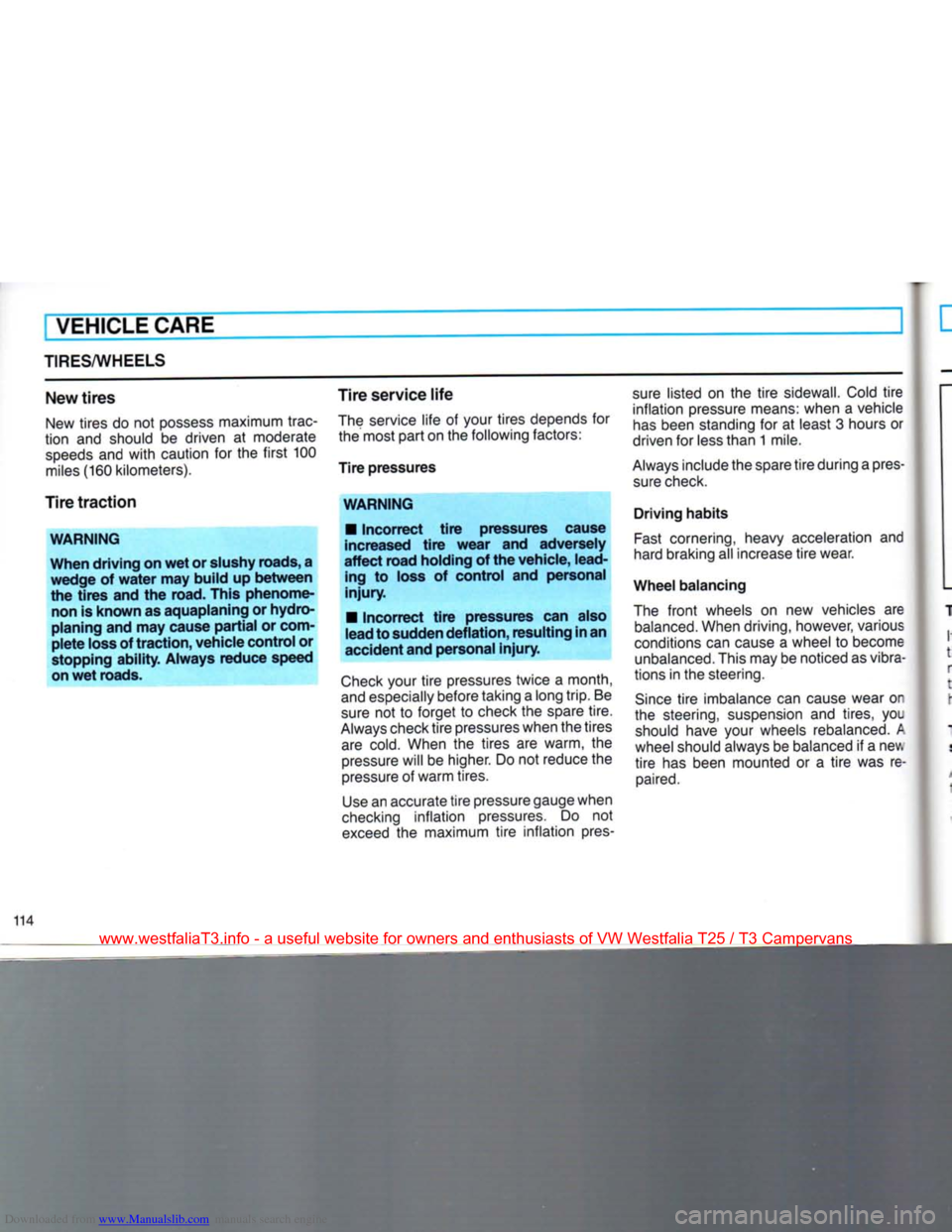
Downloaded from www.Manualslib.com manuals search engine
VEHICLE CARE
TIRES/WHEELS
New tires
New
tires
do not
possess
maximum trac
tion
and
should
be
driven
at
moderate
speeds
and
with
caution
for the
first
100
miles (160 kilometers).
Tire traction
WARNING
When driving on wet or slushy roads, a wedge of
water
may build up
between
the tires and the road. This phenome non is known as aquaplaning or hydro
planing and may cause
partial
or
com
plete
loss
of traction, vehicle control or
stopping ability. Always reduce speed
on
wet roads.
Tire service life
The service
life
of
your tires depends
for
the most
part
on the following factors:
Tire pressures
WARNING
•
Incorrect
tire
pressures cause
increased
tire
wear
and adversely
affect
road holding of the vehicle, lead ing to
loss
of control and personal
injury.
•
Incorrect
tire
pressures can also
lead to
sudden
deflation, resulting
in
an
accident and personal injury.
Check
your
tire
pressures twice
a
month,
and especially before taking
a
long
trip.
Be
sure
not to
forget
to
check
the
spare tire.
Always check
tire
pressures when the tires are cold. When
the
tires
are
warm,
the
pressure
will
be
higher.
Do not
reduce
the
pressure
of
warm tires.
Use
an accurate
tire
pressure gauge when
checking inflation pressures.
Do not
exceed
the
maximum
tire
inflation pres sure listed
on the
tire
sidewalk Cold
tire
inflation pressure means: when
a
vehicle
has
been standing
for at
least
3
hours
or
driven
for
less than 1 mile.
Always include the spare
tire
during
a
pres sure check.
Driving habits
Fast
cornering, heavy acceleration
and
hard braking all increase
tire
wear.
Wheel balancing
The
front
wheels
on new
vehicles
are
balanced.
When driving, however, various
conditions can cause
a
wheel
to
become
unbalanced.
This may
be
noticed as vibra
tions
in the
steering.
Since
tire
imbalance
can
cause wear
or
the steering, suspension
and
tires,
you
should have your wheels rebalanced.
A
wheel should always
be
balanced
if a
nev,
tire
has
been mounted
or a
tire
was re
paired.
114
www.westfaliaT3.info - a useful website for owners and enthusiasts of VW Westfalia T25 / T3 Campervans
Page 120 of 165
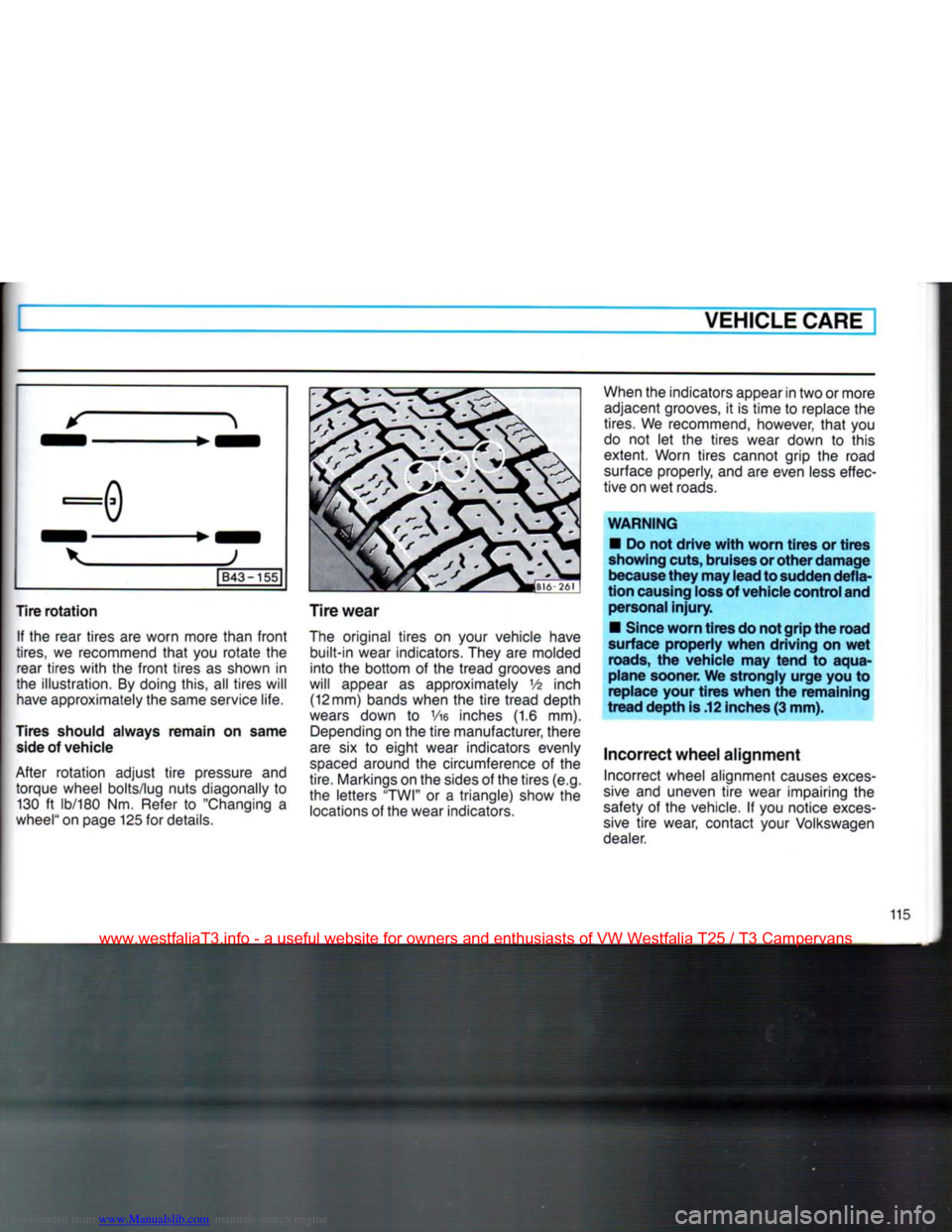
Downloaded from www.Manualslib.com manuals search engine
VEHICLE CARE
K >i
|B43-155|
Tire rotation If the
rear tires
are
worn more than
front
tires,
we
recommend
that
you
rotate
the
rear tires
with
the
front
tires
as
shown
in
the illustration.
By
doing this,
all
tires will
have
approximately the same service life.
Tires
should always remain on same
side
of vehicle
After rotation adjust
tire
pressure
and
torque wheel bolts/lug nuts diagonally
to
130
ft
lb/180
Nm.
Refer
to
"Changing
a
wheel"
on page 125
for
details.
Tire
wear
The
original tires
on
your vehicle have
built-in wear indicators. They
are
molded
into
the
bottom
of the
tread grooves
and
will appear
as
approximately
V6
inch (12 mm) bands when
the
tire
tread depth
wears
down
to Vie
inches
(1.6 mm).
Depending
on the
tire
manufacturer, there
are
six to
eight wear indicators evenly
spaced
around
the
circumference
of the
tire. Markings on the sides
of
the tires (e.g.
the letters "TWI"
or a
triangle) show
the
locations
of
the wear indicators.
When
the indicators appear in two
or
more
adjacent grooves,
it is
time
to
replace
the
tires.
We
recommend, however,
that
you
do
not let the
tires wear down
to
this
extent. Worn tires cannot grip
the
road
surface
properly, and are even
less
effec
tive on wet roads.
WARNING
•
Do not drive
with
worn tires or tires
showing
cuts,
bruises
or other damage
because
they may lead to
sudden
defla
tion
causing
loss
of
vehicle
control
and
personal
injury.
•
Since
worn tires do not grip the road
surface
properly when driving on wet
roads,
the vehicle may tend to aqua
plane sooner. We strongly urge you to
replace your tires when the remaining
tread depth is .12
inches
(3 mm).
Incorrect
wheel
alignment
Incorrect wheel alignment
causes
exces
sive
and
uneven
tire
wear impairing
the
safety
of the
vehicle.
If
you notice
exces
sive
tire
wear, contact your Volkswagen
dealer.
115
www.westfaliaT3.info - a useful website for owners and enthusiasts of VW Westfalia T25 / T3 Campervans
Page 122 of 165
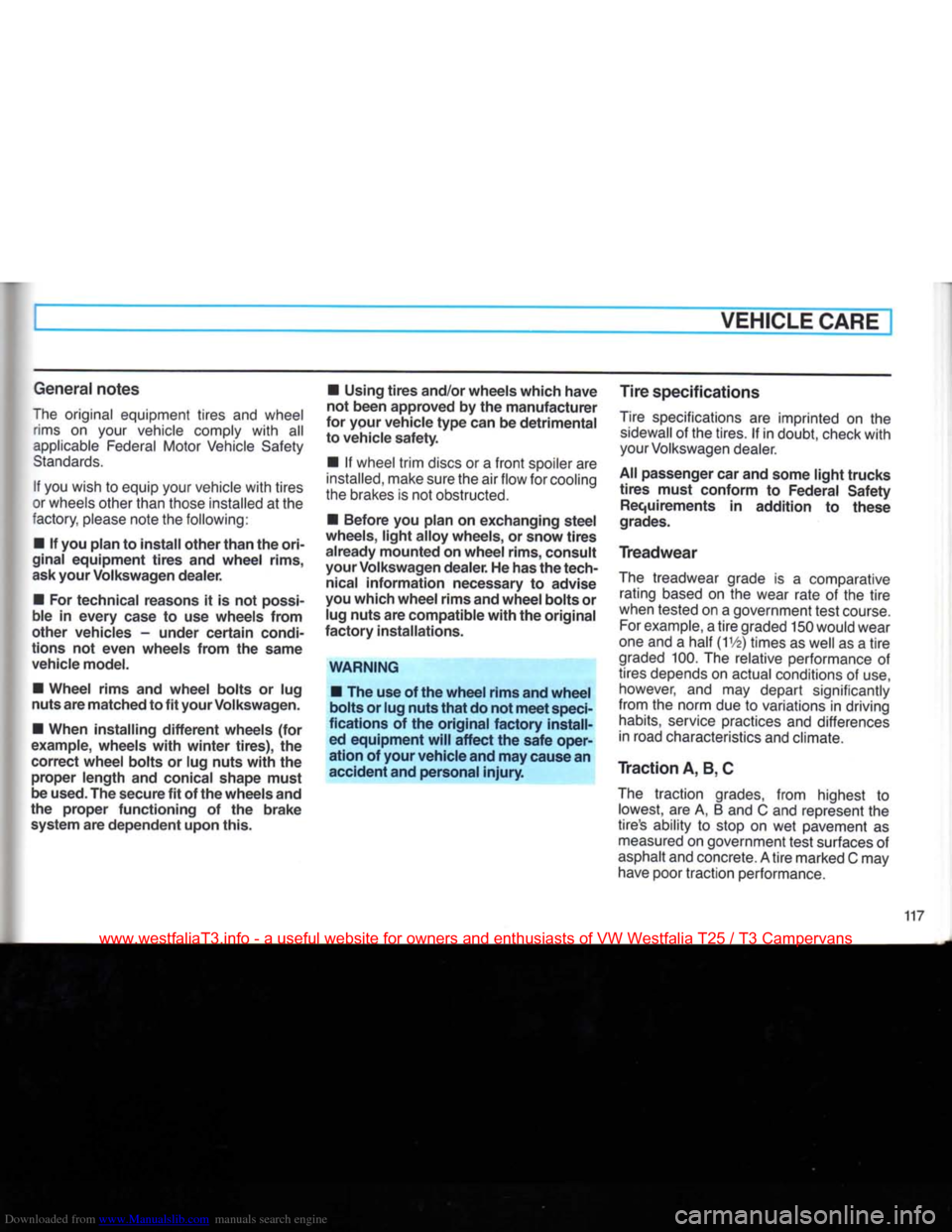
Downloaded from www.Manualslib.com manuals search engine
VEHICLE
CARE
General notes
The original equipment tires
and
wheel
rims
on
your
vehicle comply with
all
applicable
Federal Motor Vehicle Safety
Standards.
If you
wish
to
equip
your
vehicle with tires
or wheels other than those installed
at the
factory, please note
the
following:
•
If
you plan
to
install other than the
ori
ginal
equipment tires
and
wheel rims,
ask
your
Volkswagen dealer.
•
For
technical reasons
it is not
possi
ble
in
every
case
to use
wheels from
other vehicles
-
under certain condi
tions
not
even wheels from
the
same
vehicle
model.
•
Wheel rims
and
wheel bolts
or lug
nuts are matched to fit
your
Volkswagen.
•
When installing different wheels
(for
example,
wheels with winter tires),
the
correct wheel bolts
or
lug nuts with
the
proper length
and
conical shape must
be used. The secure fit of the wheels and
the proper functioning
of the
brake system are dependent upon this.
•
Using tires and/or wheels which have
not been approved
by
the manufacturer
for
your
vehicle
type
can be detrimental
to vehicle safety.
•
If
wheel trim discs
or a
front
spoiler
are
installed,
make
sure the airflow for cooling
the brakes
is not
obstructed.
•
Before
you
plan
on
exchanging steel
wheels, light alloy wheels,
or
snow tires
already mounted on wheel rims, consult
your
Volkswagen dealer. He has the tech
nical
information necessary
to
advise
you which wheel rims and wheel bolts
or
lug
nuts are compatible with the original
factory installations.
WARNING
•
The
use of the wheel rims and wheel
bolts
or
lug nuts that do not meet
speci
fications
of the
original factory
install
ed equipment will affect the safe oper
ation
of
your
vehicle and may cause an
accident and personal
injury.
Tire specifications
Tire
specifications
are
imprinted
on the
sidewall
of
the tires.
If in
doubt, check with
your
Volkswagen dealer.
All
passenger car and some light trucks tires must conform
to
Federal Safety
Requirements
in
addition
to
these
grades.
Treadwear
The treadwear grade
is a
comparative
rating
based
on the
wear rate
of the
tire
when tested
on a
government test course. For example,
a
tire graded
150
would wear
one
and a
half
(IV2)
times
as
well
as a
tire
graded 100.
The
relative performance
of
tires depends
on
actual conditions
of use,
however,
and may
depart significantly
from
the
norm
due to
variations
in
driving
habits,
service practices
and
differences
in road characteristics and
climate.
Traction A, B, C
The traction grades, from highest
to
lowest,
are A, B and C and
represent
the
tire's ability
to
stop
on wet
pavement
as
measured
on
government test surfaces
of
asphalt
and concrete. Atire marked
C
may
have poor traction performance.
www.westfaliaT3.info - a useful website for owners and enthusiasts of VW Westfalia T25 / T3 Campervans
Page 125 of 165
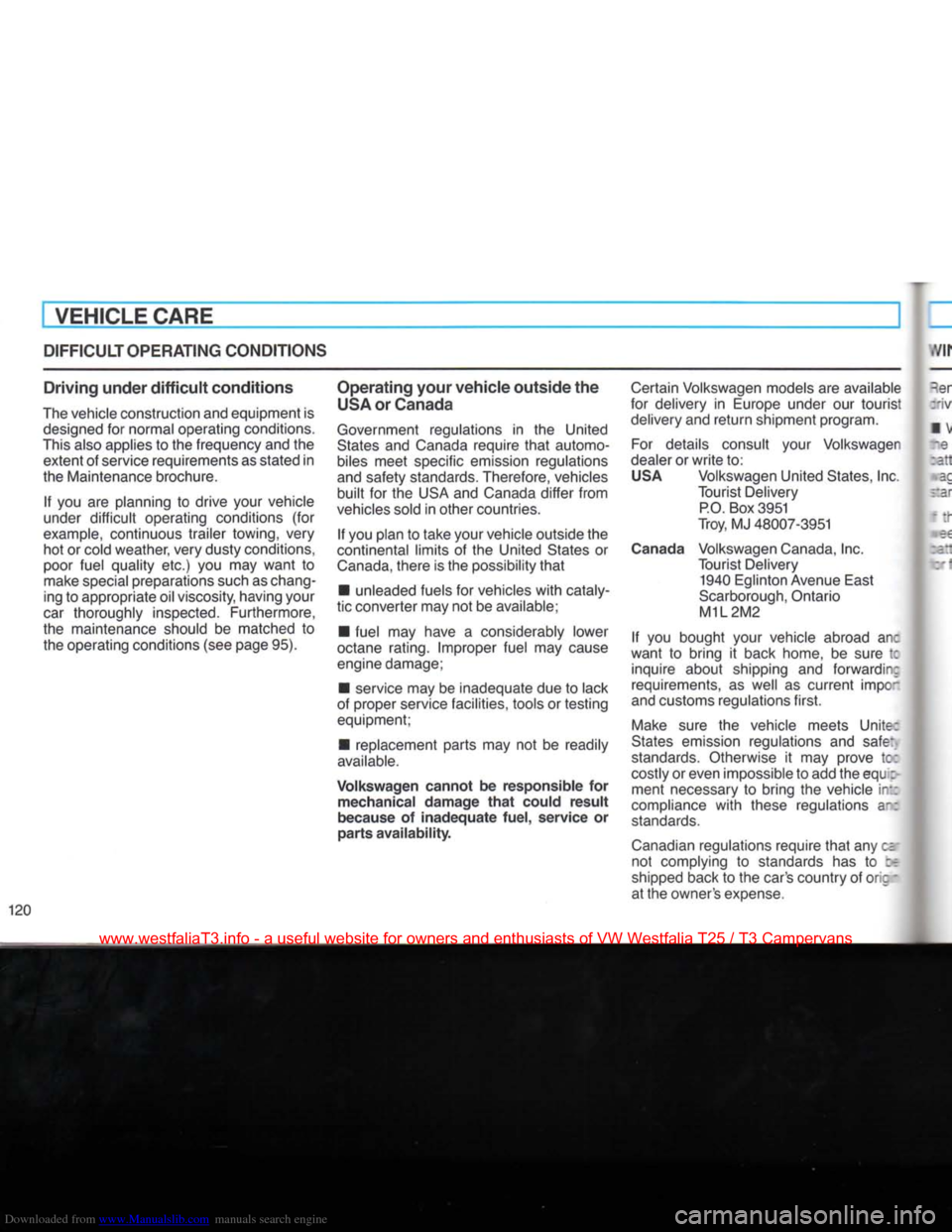
Downloaded from www.Manualslib.com manuals search engine
[VEHICLE
CARE
DIFFICULT
OPERATING
CONDITIONS
Driving
under
difficult
conditions
The
vehicle construction and equipment is
designed
for normal operating conditions.
This
also applies to the frequency and the extent of service requirements as stated in
the Maintenance brochure.
If you are planning to drive your vehicle
under
difficult
operating conditions (for
example,
continuous trailer towing, very hot or cold weather, very dusty conditions,
poor fuel quality etc.) you may
want
to
make
special preparations such as chang
ing to appropriate oil viscosity, having your
car
thoroughly inspected. Furthermore,
the maintenance should be matched to
the operating conditions (see page 95).
Operating
your
vehicle
outside
the
USA
or
Canada
Government
regulations in the United
States
and
Canada
require
that
automo
biles
meet specific emission regulations
and
safety standards. Therefore, vehicles
built
for the USA and
Canada
differ
from
vehicles
sold in other countries.
If you plan to take your vehicle outside the
continental limits of the United States or
Canada,
there is the possibility
that
• unleaded fuels for vehicles
with
cataly
tic converter may not be available;
• fuel may have a considerably lower
octane rating. Improper fuel may cause
engine damage;
• service may be inadequate due to lack
of proper service facilities, tools or testing
equipment;
• replacement parts may not be readily
available.
Volkswagen
cannot be responsible for
mechanical
damage
that
could result
because
of inadequate fuel, service or
parts availability.
Certain
Volkswagen models are available
for delivery in Europe under our
tourist
delivery and
return
shipment program.
For
details consult your Volkswagen
dealer
or
write
to:
USA
Volkswagen United States, Inc. Tourist Delivery
P.O.
Box 3951
Troy, MJ 48007-3951
Canada
Volkswagen
Canada,
Inc. Tourist Delivery 1940 Eglinton Avenue
East
Scarborough,
Ontario
M1L2M2
If you bought your vehicle abroad an:
want
to bring it back home, be sure M inquire about shipping and forwardin:
requirements, as well as current impc
and
customs regulations
first.
Make
sure the vehicle meets Unite:
States
emission regulations and safe:
standards.
Otherwise it may prove tc:
costly
or even impossible to add the eqi : ment necessary to bring the vehicle in::
compliance
with
these regulations a-:
standards.
Canadian
regulations require
that
any c= not complying to standards has to
shipped
back to the car's country of oric -
at the owner's expense.
www.westfaliaT3.info - a useful website for owners and enthusiasts of VW Westfalia T25 / T3 Campervans
Page 128 of 165
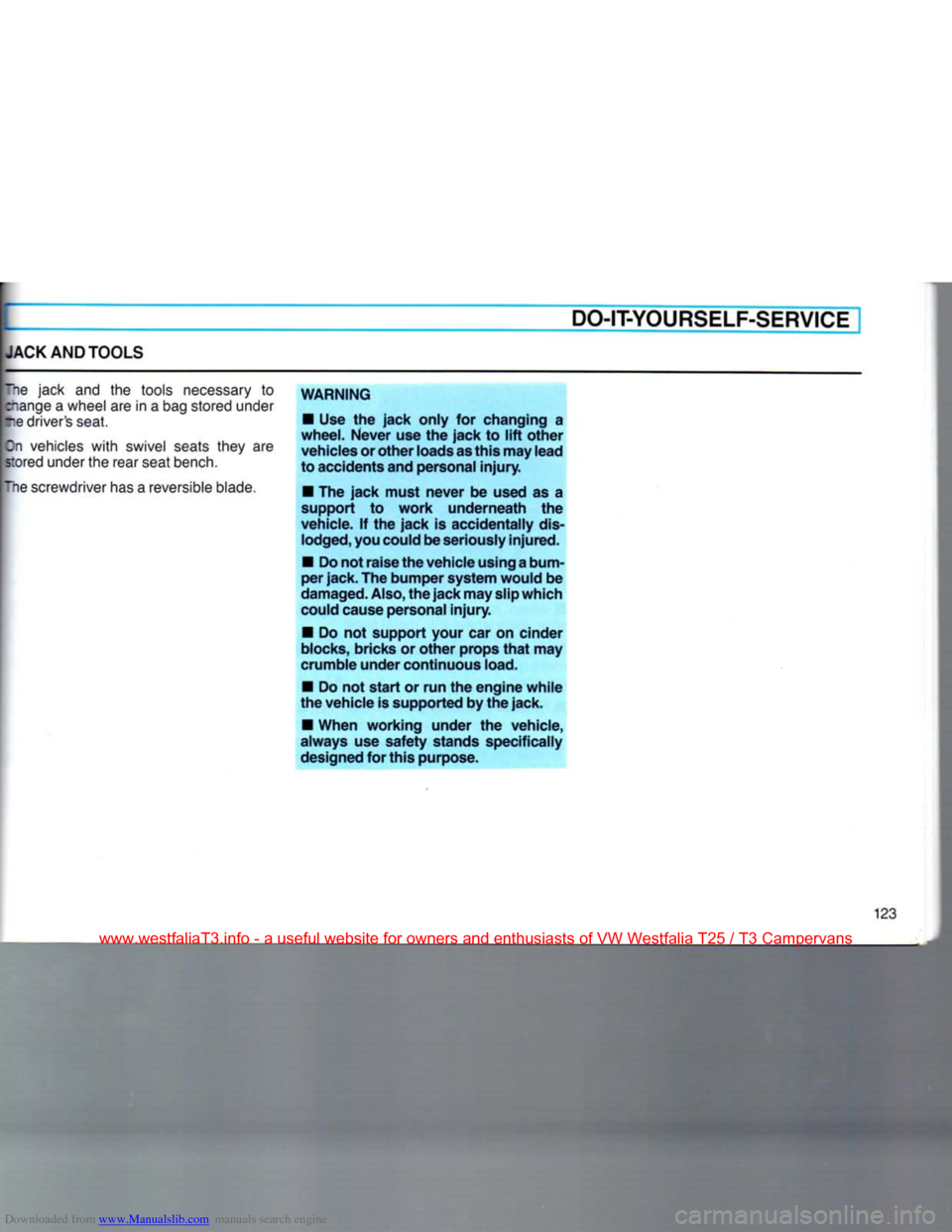
Downloaded from www.Manualslib.com manuals search engine JACK AND
TOOLS
DO-IT-YOURSELF-SERVICE
The jack and the tools necessary to
Bange
a wheel are in a bag stored under
re driver's seat.
Zn vehicles
with
swivel seats they are
stored under the rear seat bench.
~ne
screwdriver has a reversible blade.
WARNING
• Use
the
jack only
for
changing
a
wheel.
Never
use the jack
to
lift other vehicles or other loads
as
this may lead
to accidents and personal
injury.
• The jack must
never
be
used
as a
support
to
work underneath
the
vehicle.
If
the jack
is
accidentally dis lodged, you could be seriously injured.
• Do not
raise
the vehicle using
a
bum
per
jack.
The bumper system would be
damaged.
Also, the jack may
slip
which
could cause personal
injury.
•
Do not
support
your
car on cinder
blocks,
bricks or other props that may
crumble under continuous
load.
• Do not start
or
run the engine while
the vehicle is supported by the jack.
• When working under
the
vehicle,
always
use
safety stands specifically
designed for this purpose.
123
www.westfaliaT3.info - a useful website for owners and enthusiasts of VW Westfalia T25 / T3 Campervans